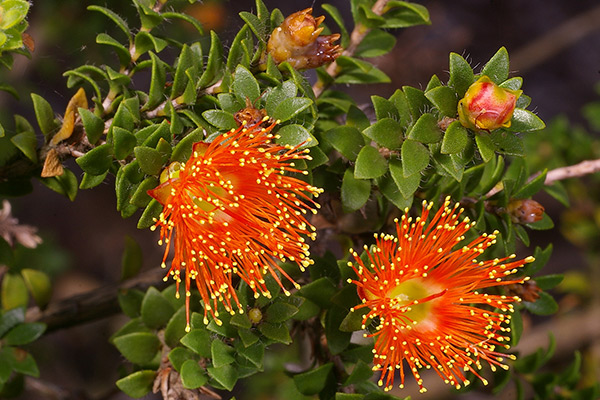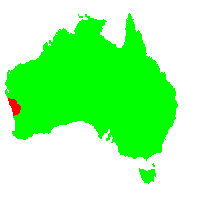General Description:
Eremaea is a small genus of about 15 species, all of which occur naturally only in south Western Australia. The genus is closely related to Beaufortia and the more familiar Melaleuca, all three genera having stamens which are joined into clusters. The difference between the genera is in the arrangement of the anthers (the pollen bearing structures of the flowers). In Eremaea and Beaufortia these are attached to the stamens at their bases (basifixed) whereas in Melaleuca the anthers are attached along their sides (versatile).
Eremaea beaufortioides is the best known member of the genus and the most commonly cultivated. It is an erect or spreading shrub from 0.5 to 2.5 metres high with oval to narrowly lance-shaped leaves about 5 mm long. The orange flowers appear as circular clusters at the ends of the branches. they are 10-12 mm in diameter and are seen in spring. There are three recognised varieties (var. beaufortioides, var. lachnosanthe and var. microphylla) which have subtle differences in flower and foliage structures.
This species is a very attractive garden plant for climates with low summer humidity. It has been cultivated in humid, east-coastal areas and although more successful than plants from a similar habitat, it cannot be regarded as totally reliable there. However, recently plants grafted on to hardy root stocks have become available and these are much more successful than plants on their own roots. The plant requires well drained conditions in full sun or dappled shade and it is tolerant of at least moderate frost. It also responds well to pruning if needed and the colourful flower clusters are attractive to birds.
Propagation is easy from both seed and cuttings. Seed does not require any pretreatment. Grafting onto reliable Melaleuca, Callistemon and Kunzea rootstocks has been reported as successful.

Eremaea beaufortioides
Photo: Brian Walters
 Australian Native Plants Society (Australia)
Australian Native Plants Society (Australia)













